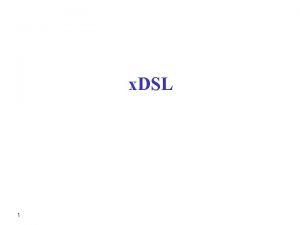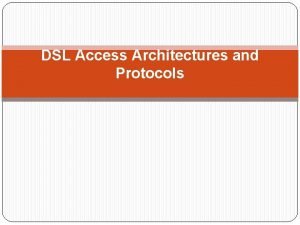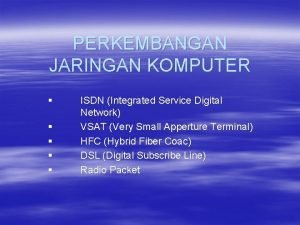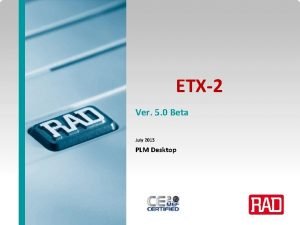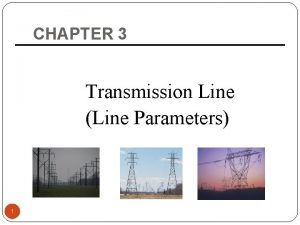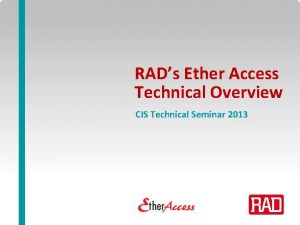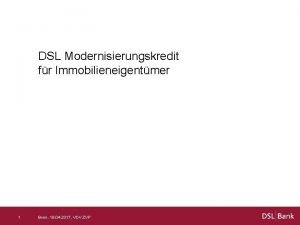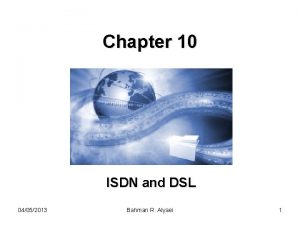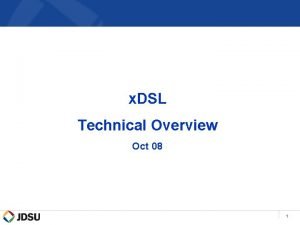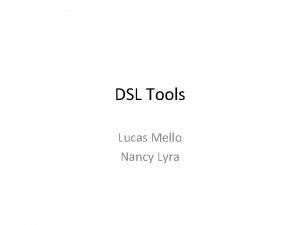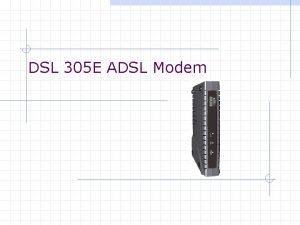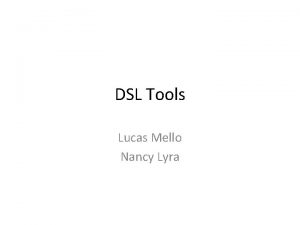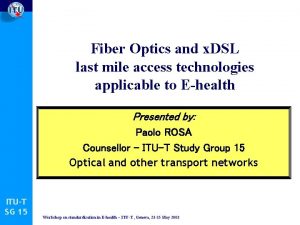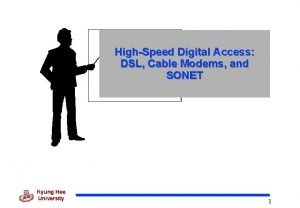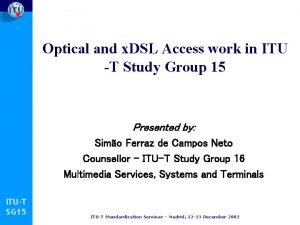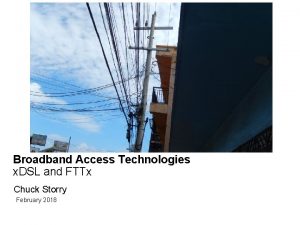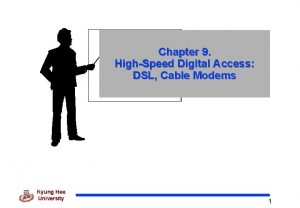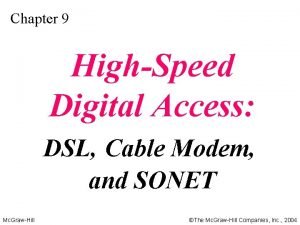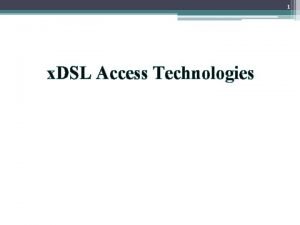DSL in the access network technical and regulatory

























- Slides: 25

DSL in the access network – technical and regulatory challenges The Danish case TRIS Meeting 17 June, 2010 Keld Skov Network Division, R&D TDC keask@tdc. dk June 17 th, 2010 TRIS meeting, Vilnius

Agenda 1. Background and issue 2. DSL in the Danish access networks – present status Co-existence measures and unbundling Revised access network strategy Regulatory challenges and possible solutions: Technical and regulatory 3. 4. 5. June 17 th, 2010 TRIS meeting, Vilnius 2

Background: Role of NGA in DK and the regulatory conditions BB Strategy § A political demand for more high-speed broadband both coverage and speed (2050 Mb) however based on a technology neutral and market driven development § In Denmark triple play services incite a growth in demand for BB > ADSL 2+ (>10 -15 Mb) § TDC’s BB strategy thus aims at both matching and encouraging demand in a cost-effective manner relying on existing resources where possible Regulatory conditions TDC is designated as smp operator in the access markets (market 4 and 5) TDC has to provide a full range of unbundling and BSA products at LRAIC regulated prices • For the LLU products TDC is required to maintain a given line quality with only very few exceptions (e. g. public roadwork) • The industry has agreed on a Cable Management Plan monitored by the NRA to avoid technical/operational conflicts (degradation, cross-talk. . ) § • June 17 th, 2010 TRIS meeting, Vilnius 3

Background: TDC continues to build out of high speed broadband leveraging mix of access technologies… Timeline 2010 - 2013 § COPPER § § COAX FIBER CORE June 17 th, 2010 TRIS meeting, Vilnius 4 § § § 2014 - 2020 § Build out with VDSL in street cabinets. The build out areas include 20 % of the households in Denmark Build out with VDSL in street cabinets will continue to 2015 to reach a further 10 % of the households § VDSL in street cabinets will increase the typical potential bandwidth from 10– 20 Mbps to 35– 50 Mbps VDSL technology development is expected to increase the bandwidth potential to 100 Mbps § To achieve this various options will be considered e. g. vectoring § Over the period the coax network will be upgraded with new amplifiers driven by actual capacity demands Coax access will end of the period still be able to serve customers’ need for bandwidth near 1 Gbps and high quality TV broadcast services (SD, HD and 3 D) DOCSIS and VOD capacity expansion in coax networks will continue DOCSIS will increase potential bandwidth to 500 Mbps VOD services will concurrently serve 10% of customers HFC networks will continue to offer leading on speed and video services § § Fiber feeder network will be completed. 80 % of the households will be within 500 m reach of the fiber feeder network by 2020 The fibre feeder network will provide backhaul to all access technologies including remote VDSL, coax, FTTH, mobile antenna and fibre to businesses Acceleration of FTTH to reach 500. 000+ homes passed § TDC will establish an all-fiber feeder network in the densely populated areas in Denmark § 33 % of the households will be within 500 m reach of the fiber feeder network by 2013 § FTTH will gradually be introduced in green field areas § TDC continues with a single Nordic IP-core consolidating all traffic § Legacy networks including PSTN, ATM and SDH will be decommissioned by 2017 § TDC will closely manage the risks associated with running All Services (ALL-IP) on single IP-CORE Infrastructure § New central office architecture will be introduced as remote VDSL and FTTH makes the existing copper MDF’s redundant § §

2 DSL in the Danish access network – present status June 17 th, 2010 TRIS meeting, Vilnius

Loops and technology – present status • ADSL 2+ and VDSL 2 is deployed at almost all COs • VDSL 2 is deployed in a limited number of cabinets Total number of loops served by TDC with ADSL/2+ or VDSL 2 is a little less that 1. 000 including BSA. The number has been almost constant for more than one year Number of lines with dual- or triple play services is growing fast Number of unbundled lines is approximately 225. 000 Up to now the main planning target for TDC has been optimising coverage with DS bitrates up to 20 Mb/s • • June 17 th, 2010 TRIS meeting, Vilnius 6

Present status primo 2010: TDC offers DSL from over 1900 active points 1183 Central Offices Nearly 400 ”old” sub-COs ca. 350 cabinet DSLAMs June 17 th, 2010 TRIS meeting, Vilnius 7

x. DSL coverage in TDC fixed network (downstream bitrates) ADSL technology improves Launch of Long Reach MMDSL launch ADSL build out 4 Mbps possible Remote DSLAM build out ADSL 2+ launch June 17 th, 2010 TRIS meeting, Vilnius 8 VDSL 2 launch ADSL 2+ build out

3 Unbundling and coexistance measures June 17 th, 2010 TRIS meeting, Vilnius

How co-existence is achieved In a network with CO as well as cabinet deployment, protection measures have to be taken in order to avoid unacceptable mutual degradation of signals due to crosstalk • In addition to common harmonisation of VDSL 2 frequency plan and Upstream Power back off profile for VDSL 2, the following 2 protection rules apply according to the Danish spectrum plan: • 1. Downstram Power Backoff, or spectral shaping, is applied to cabinet injected VDSL 2 signals, in order to protect ADSL 2+ and SHDSL from CO - “Equal Pain protection” 2. A VDSL 2 protection zone is defined around COs. Cabinet deployment of VDSL 2 is not allowed inside this zone. June 17 th, 2010 TRIS meeting, Vilnius 10

Co-existence 1: Signals at injection point Example of DPBO applied at cabinet DSLAM placed ~2500 m from CO • • ADSL 2+ signal injected at CO is attenuated by the cable. Attenuation increases with frequency DPBO attenuates the injected VDSL 2 signal to the same level as the signal transmitted by the cable from CO ~ 2500 m Cable attenuation DSLAM in CO ADSL 2+ signal at cabinet DSLAM in cabinet June 17 th, 2010 TRIS meeting, Vilnius 11 ADSL 2+ signal at CO VDSL 2 signal with DPBO

Co-existance 1: VDSL 2 loss of performance due to DPBO This plot shows data from live network It is evident that DPBO significantly reduces DS bitrates on long loops, but not on short loops Blue points: No DPBO (CO DSLAM) Red points: DPBO (Cabinet DSLAM) June 17 th, 2010 TRIS meeting, Vilnius 12

Co-existance 2: Protection of VDSL 2 from CO Due to the high frequencies used and the associated strong crosstalk coupling, it is not possible to establish co-existence between VDSL 2 systems injected at two different points in the network. • Separation in different frequency bands to achieve co-existence is possible, but this significantly reduces the bitrates • In the Danish spectrum plan co-existence between VDSL 2 systems is achieved by prohibiting cabinet deployment of VDSL 2 closer to CO than 8 d. B@150 k. Hz, about 1000 m. • 8 d. B@150 k. Hz ~ 1000 m DSLAM in CO Modems DSLAM in cabinet June 17 th, 2010 TRIS meeting, Vilnius 13

Unbundled loops/subloops and co-locations • 225. 000 LLU contracts and 894 co-location contracts on 376 COs or sub Cos • No sub-LLU or co-housing contracts at cabinet positions June 17 th, 2010 TRIS meeting, Vilnius 14

4 Revised Access network strategy June 17 th, 2010 TRIS meeting, Vilnius

Revised access network strategy During 2 H 2009 extensive analytic work was carried out at TDC in order to update the access net strategy The (preliminary) revised strategy is based on the following elements: Target (planning) bandwidth raised from 20 to 50 Mb/s DS 2000 -2500 new cabinet DSLAMs with VDSL 2 build 2011 -13 FTTH in areas where new infrastructure is build – deployment of new copper cables will be limited to a minimum • Common technical platform for VDSL 2 and Pt. P fibre (DSLAM with fibre optical line cards) • Due to requirements for high bandwidth, radius for area covered by one VDSL 2 injection point is reduced from about 1200 metre to 4 -500 metre • • • June 17 th, 2010 TRIS meeting, Vilnius 16

To deliver 50 Mb/s guaranteed bandwidth with conventional VDSL 2 technology, loop length must not exceed 4 -500 m DS guaranteed bandwidth - metre 0, 4 mm cable 1: 17 MHz, high fill 2: 17 MHz, low fill 3: 30 MHz, high fill 4. 30 MHz, low fill Frequency plans 998 E 17 or 998 E 30 assumed Metre 0, 4 mm cable. 100 m ~ 1 d. B@150 k. Hz June 17 th, 2010 TRIS meeting, Vilnius 17

New strategy for upgrading the access network to bitrates around 50 Mbit/s - calculations based on generic model • 25 -30 % of customers should be offered 50 Mbit/s before the end of 2013 • 2. 000 – 2. 500 cabinet DSLAMs must be build, mainly in city and town areas during 2011, 2012 and 2013 DSLAM cabinets will be placed next to existing cabinets Primarily 192 ports i each DSLAM, at some locations 96 ports DSLAMs connected to layer 2 fibre ring New cabinets considerably smaller that type used up to now in order to minimise problems with obtaining planning permission in city areas New DSLAMs will not be equipped with splitter filters – this means no POTS • • • June 17 th, 2010 TRIS meeting, Vilnius 18 Generic model is based on a grid 250*250 m covering the whole country. Cost and customer potential in each square is then calculated and can be tuned using different pay-back times, different assumptions for uptake etc.

Generic model and the real world One cabinet DSLAM placed next to major passive cabinets June 17 th, 2010 TRIS meeting, Vilnius 19

VDSL 2 protection zone around CO of 8 d. B@150 k. Hz (about 1000 m) leaves a grey zone where very high bandwidths cannot be offered CO DSLAM 50 Mbit/s ~ 4 -5 d. B VDSL 2 -protection zone 8 d. B June 17 th, 2010 TRIS meeting, Vilnius 20

Example form Silkeborg. In this case the grey zone affects a limited number of households June 17 th, 2010 TRIS meeting, Vilnius 21

Example form Helsingør. Here the grey zone affects a large number of households June 17 th, 2010 TRIS meeting, Vilnius 22

5 Regulatory challenges and possible solutions: Technical and regulatory June 17 th, 2010 TRIS meeting, Vilnius

VDSL roll out: Operational/regulatory challenges -> Starting point: TDC believes the most cost-effective way to roll out NGA is to progressively move to FTTC/VDSL and then further to FTTH as • x. DSL can both technically and economically meet the BB demand for many customers • TDC has presented investment plans that makes 50 Mbit/s available for 25 -30% of the population before end of 2013 • Alternative operators then have a choice between BSA or own DSLAM in accordance with their own strategy and number of customers -> Problems: Qo. S (‘VDSL safety zones’) • Moving to higher bandwidths means smaller coverage areas around each cabinet – this means even further reduced customer base • For operators with smaller customer base, cabinet deployment will in general not be a realistic proposition • TDC is in dialog with other main operators and the Danish regulator on this issue which must be solved if the technical potential of VDSL 2 is to be fully exploited June 17 th, 2010 TRIS meeting, Vilnius 24

VDSL roll out: Possible solutions • A reduced VDSL 2 safety zone is necessary to avoid coverage gaps (grey zones) • A reduced safety zone may be in conflict with a Market 4 decision on preserving transmission quality of existing LLUs, when the network is changed by TDC -> Possible solutions • TDC is in dialog with other main operators and the Danish regulator on this issue which must be solved, if all citizens in the build out areas are to enjoy the high bandwidths the technology allows • Improved BSA offering – Virtual Unbundling – seems a possible road ahead in cases where physical duplication of infrastructure elements is not economically feasible, and competition must be promoted using other remedies June 17 th, 2010 TRIS meeting, Vilnius 25
 Dsl 1 dsl 2
Dsl 1 dsl 2 Dsl architecture
Dsl architecture Nottingham city lado
Nottingham city lado Isdn komputer adalah
Isdn komputer adalah Gene regulatory network
Gene regulatory network Gene regulatory network
Gene regulatory network Gene regulatory network
Gene regulatory network Technical rope access services uae
Technical rope access services uae Terminal access controller access control system plus
Terminal access controller access control system plus Terminal access controller access-control system
Terminal access controller access-control system Primo dsl
Primo dsl Etx203
Etx203 Gmr of 7 strand conductor
Gmr of 7 strand conductor Ad-dsl
Ad-dsl Andrew hall safeguarding
Andrew hall safeguarding Weex web app
Weex web app Etheraccess
Etheraccess Dsl adalah
Dsl adalah Modernisierungskredit bonn
Modernisierungskredit bonn Isdn vs dsl
Isdn vs dsl Dsl adalah
Dsl adalah Gatling randomswitch
Gatling randomswitch Atlas dsl grammar
Atlas dsl grammar Acn internet plans
Acn internet plans Planet dsl
Planet dsl Acn dsl
Acn dsl
